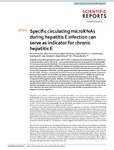Specific circulating microRNAs during hepatitis E infection can serve as indicator for chronic hepatitis E
Harms, Dominik
Choi, Mira
Allers, Kristina
Wang, Bo
Pietsch, Heiko
Papp, C.-Patrick
Hanisch, Lina
Kurreck, Jens
Hofmann, Jörg
Bock, C.-Thomas
Hepatitis E virus (HEV) genotypes 3 and 4 (HEV-3, HEV-4) infections are an emerging public health issue in industrialized countries. HEV-3 and −4 are usually self-limiting but can progress to chronic hepatitis E in immunocompromised individuals. The molecular mechanisms involved in persistent infections are poorly understood. Micro RNAs (miRNAs) can regulate viral pathogenesis and can serve as novel disease biomarkers. We aimed to explore the modulation of serum miRNAs in patients with acute (AHE) and chronic (CHE) hepatitis E. Both AHE- and CHE-patients exhibited high viral loads (median 3.23E + 05 IU/mL and 2.11E + 06 IU/mL, respectively) with HEV-3c being the predominant HEV-genotype. Expression analysis of liver-specific serum miRNAs was performed using real-time PCR. miR-99a-5p, miR-122-5p, and miR-125b-5p were upregulated in AHE (4.70–5.28 fold) and CHE patients (2.28–6.34 fold), compared to HEV-negative controls. Notably, miR-192-5p was increased 2.57 fold while miR-125b-5p was decreased 0.35 fold in CHE but not in AHE patients. Furthermore, decreased miR-122-5p expression significantly correlates with reduced liver transaminases in CHE patients. To our knowledge, this marks the first investigation concerning the regulation of circulating liver-specific miRNAs in acute and chronic HEV infections. We found that miR-125b-5p, miR-192-5p, and miR-99a-5p may prove useful in the diagnosis of chronic hepatitis E.
Files in this item

